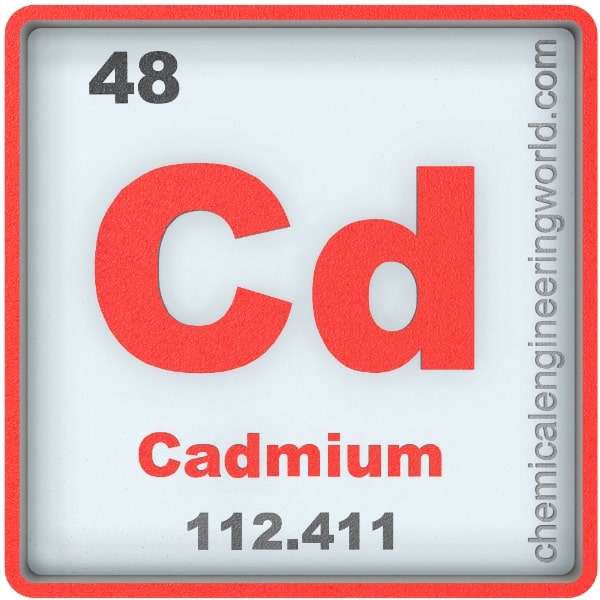Cadmium Element Properties and Information

Cadmium Element Properties and Information
Cadmium is forty-eighth element on the periodic table. Elements are arranged in the periodic table on the basis of the atomic number. Atomic number is the number of protons in the nucleus of the atom. Cadmium has an atomic number of 48. It is located in the Group 12 and Period 5 of the periodic table of elements. It is denoted by Cd. The name is derived from the Latin word ‘Cadmia’.
In the early 1800s, the apothecaries of Germany were making zinc oxide using cadmia. At that time cadmia was widely known to be a form of zinc carbonate. They found that the produced zinc oxide was slightly discoloured instead of being pure white. Friedrich Stromeyer was called in 1817 to find the cause. He seated its brown oxide and heated it with carbon to recover a metal. He couldn’t identify the metal thus concluded that it is a new metal and named it cadmium. Cadmium makes up 0.1 ppm of Earth’s crust. It is found in minor quantities mostly in zinc ores. It is found in significant quantities in a mineral called greenockite.
Physical Properties
- Cadmium is a soft silvery-white metal with a bluish tinge.
- The atomic mass of cadmium is 112.4
- The melting point of cadmium is 327°C
- The boiling point of cadmium is 767°C
- The density of cadmium is 8700 in S.I. units at 20°C
- Cadmium has eight naturally occurring isotopes.
Chemical Properties
- Cadmium does not corrode.
- Bulk cadmium is insoluble in water and is not flammable but powdered form of cadmium can burn.
- Cadmium usually is found in +2 oxidation state. Some compounds have been found to exists in +1 state also.
Methods of Production
Smelting or Electrolysis: Cadmium is always produced as a by-product during zinc production and refining. This is because many zinc ores contain cadmium as an impurity. Some zinc ores contain about 1.4% cadmium. The ores are roasted then zinc sulfides are converted to oxides. Now there are two ways to get cadmium; in the first way, zinc oxide is subjected to electrolysis thus cadmium sulfate gets precipitated in the process and second way is that the zinc oxide is subjected to smelting process with carbon and then the output is sent to vacuum distillation to get cadmium.
Relevance in Chemical and Related Industries
- Pigments: Cadmium compounds are used as pigments of various types, they provide various colours such as red, yellow, orange. They need to be toned down and blended with oils during the process due to toxicity of cadmium compounds.
- Alloys: Cadmium is added in alloys which are to be molded as solder and bearing tools because it has low coefficient of friction, and fatigue resistance.
Relevance in Other Industries
- Battery: Cadmium is used in rechargeable nickel-cadmium batteries as a negative electrode. More than 80% of cadmium is used for this purpose worldwide.
- Electroplating: Cadmium plating is done on metals to reduce the corrosion. It is especially used in aircraft industries to reduce the corrosion of steel.
- Nuclear fission: Cadmium is used in control rods as very effective neutron poison to control neutron flux.
Health Effects on Exposure
- Damage: Cadmium is a toxin which has the potential to damage nervous system, immune system, and also skeletal system. It can cause damage to cells which may develop into cancer.
- Mental harm: Cadmium is also capable of doing psychological harm.
Effects on Surroundings
- Soils: Cadmium gets absorbed in soil very fast. It can poison earth worms also the plants growing in the soil.
- Aquatic animals: Cadmium bio-accumulates in various aquatic organisms.
- Animals: Consumption of cadmium by animals raises their blood pressure, causes liver disease and can cause nerve or brain damage.
References:
https://en.m.wikipedia.org/wiki/Cadmium
https://www.lenntech.com/periodic/elements/cd.htm
































